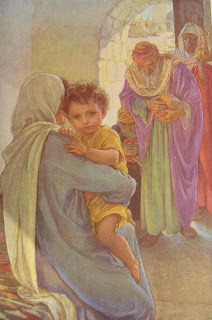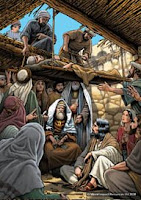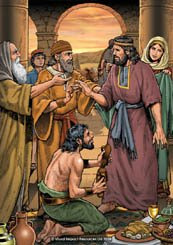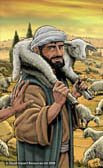Many thanks to Prof Sandy Brewer for writing our fourth 'Guest Article' for the Bible illustration blog. Click on the pictures below for a larger image.Elsie Anna Wood (1887 – 1978)
Elsie Anna Wood was born into a Baptist family who were all active in the local chapel in Crouch End, North London. Like so many other women illustrators – e.g.
Cicely Mary Barker, Margaret Tarrant and Eileen Soper - she was fortunate in having an artistically talented father to encourage her precocious talents. Charles Wood worked in the art department of a London publishing firm, and, from a very early age, she was encouraged to draw and paint , and introduced to the tools, materials and skills required of a commercial artist. Elsie attended the Hornsey School of Art from the age of seventeen but was prevented from advancing to the Academy schools of art by a change in her family’s circumstances that necessitated her seeking paid employment. She produced illustrations for various publications working only in pencil or ink and taking up the challenge of full colour illustrations for books in her early twenties. Up to this point Elsie Anna Wood’s life might have taken the trajectory of contemporaries such as Margaret Tarrant who lived and worked in the Engish Home Counties, but in 1919 she successfully applied for a job with the Nile Mission Press working under the auspices of Constance Padwick in Cairo. Her role was to provide the accompanying illustrations for the children’s literature produced by the Press. The post was for six months and enabled Elsie to travel through Palestine as well as Egypt.
After returning to the UK she unsuccessfully applied to serve as a missionary overseas, but five years after leaving Cairo she was asked to return to Egypt to work for the
Society for the Propagation of Christian Knowledge (SPCK). It is the work she produced for the SPCK that made the name of Elsie Anna Wood synonymous with Bible illustration all around the world. Many artists before her had travelled to the Holy Land - e.g. Tissot,
Hole, and
Copping – to observe at first hand the people and places of the Bible, but none of them had moved beyond the experience of a tourist to live and work among the people as Elsie Anna Wood did. As a result of her close observation and drawing from Palestinian models, she has, uniquely, shown us a Christ from Palestine which is in stark contrast to the conventional blonde European portrayal of Jesus adopted by most twentieth century Bible illustrators. But her bible illustrations were innovative in other ways too.

In her illustration of the infant Jesus
(left) she shows us a self-confident child who looks out – confrontationally - at the audience.
In the background detail of picture 1,
(above right) she reminds us that Jesus spent his early years in Egypt.
Dr Brewer pointed out to me that the boats in the background of picture one (above) are 'Dhows' which were traditional Arab sailing vessels. GKIn picture 4,
(bottom centre), the depiction of Jesus as healer, she conveys the light and shade and the movement of the crowd in the confined space of a Palestinian town. Finally, in what is my favourite of all of her illustrations of Jesus blessing the children
(below right) she makes the disciples sympathetic characters and does away with the forbidding effect they might have on young viewers.

It is an interesting composition which adopts as its point of view that of a child and the effect produced is one of looking upwards to Jesus. There is also a strong impression created of a crowd pressing in on Christ and, as in other versions of the scene, there is a tree arching over the top of the picture, but this one is laden with pomegranates – a fruit with particular symbolic significance for Christians. As we look longer into the picture, other small figures become visible, one of whom is holding onto Jesus’ robe, smiling shyly while looking out at the viewer. Jesus is shown holding one small child, as is the convention in the scene, but what is different here is that he is reaching out to touch the head of a baby, which is being held by one of the disciples. This man is looking down at the baby with what appears to be puzzlement and Christ is depicted as looking at him and smiling. At the top left of the picture is another disciple, again with an infant in his arms. This is not a scene of rejection but of joyful happiness and among its many innovations is that Jesus is shown with his hair cut short and his beard clipped, as are the disciples who look like the young men they actually were, rather than the elderly patriarchs of convention.
This picture is carefully composed to take account of the predispositions of the very young child. For example, it is notable that in many hymns for children the writers never seem to tire of stressing the smallness of children yet this picture offers a way for the young viewer to overcome the limitations of its small stature in relation to that of adults. The dynamic of the composition is created by the line of sight which starts with the mother in the bottom left hand corner, moves up past the two small children, on to Jesus’ face, and ends with the smiling face of a little girl sitting on her mother’s shoulders. It is an adult who is in the lowest position in the picture and a child in the highest.
The format of Sunday school kindergarten lesson was the telling of an illustrated story, followed by activities linked to what had been heard. Within that context, this picture offers a multitude of opportunities for imaginative engagement with what is being depicted. Because some of the detail is half-hidden in the picture, it offers the chance of a game of seeking out visual information – an activity that requires the involvement of the teacher. The attention to detail of dress and ornamentation is again typical of the artist, but also indicative of the level of authenticity that publishers and educationalists expected. Learning about the dress, the customs, and geography of the Holy Land was all part of the process of making Christ real for children. Having lived and worked in the Holy Land, Wood was familiar with the inhabitants and was able to produce depictions of Jesus, his disciples and the people around him as clearly belonging to Palestine, whilst at the same time avoiding the orientalist excesses of other illustrators.

Elsie Anna Wood produced over 100 bible illustrations for the SPCK, which were published in various formats as books, postcards, attendance stamps, as well as large posters for the Sunday school classroom. The pictures were produced for educational purposes and to that end seem to transcend the limitations of two dimensions by compositional devices which draw the viewer further into the picture the longer one looks at it.
Elsie Anna Wood was a remarkable woman making her own living in the UK and the Holy Land at a time when society deemed a woman’s place to be in the home. She was not only a brilliant artist, she was also more astute in her business dealings than other Bible illustrators. When Harold Copping produced his sixty-four illustrations for the Religious Tract Society he was given a fixed sum for each completed picture with no royalties for the millions of reproductions which followed from his work. In addition, he was legally prohibited by the society from producing Bible illustrations for any other publisher. Elsie Anna wood on the other hand, had the foresight to opt for a contract, which gave her royalties on reproductions of her work and not just a one-off payment for each picture. This gave her a steady, if modest income which supported her through her long and productive life. Elsie Anna Wood died in a Norwich nursing home in 1978 but her work lives on, albeit with substantially less public recognition than it deserves. These short notes offer just a brief overview of the artist and a longer article will surface in the near future.
© Dr Sandy Brewer 2008
Related posts:
More 'Elsie Anna Wood' Bible ArtA Gift Returned with Love.
 The question below comes from Bible artist Greg Owen from the U.S.
The question below comes from Bible artist Greg Owen from the U.S.




.jpg)
.jpg)






























